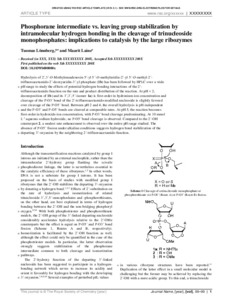Phosphorane intermediate vs. leaving group stabilization by intramolecular hydrogen bonding in the cleavage of trinucleoside monophosphates: implications for understanding catalysis by the large ribozymes
Laine M; Lonnberg T
Phosphorane intermediate vs. leaving group stabilization by intramolecular hydrogen bonding in the cleavage of trinucleoside monophosphates: implications for understanding catalysis by the large ribozymes
Laine M
Lonnberg T
ROYAL SOC CHEMISTRY
Julkaisun pysyvä osoite on:
https://urn.fi/URN:NBN:fi-fe2021042714837
https://urn.fi/URN:NBN:fi-fe2021042714837
Tiivistelmä
Hydrolysis of 2',3'-O-methyleneadenosin-5'-yl 5'-O-methyluridin-2'-yl 5'-O-methyl-2'-trifluoroacetamido-2'-deoxyuridin-3'-yl phosphate (1b) has been followed by HPLC over a wide pH range to study the effects of potential hydrogen bonding interactions of the 2'-trifluoroacetamido function on the rate and product distribution of the reaction. At pH < 2, decomposition of 1b (and its 3',3',5'-isomer 1a) is first-order in hydronium-ion concentration and cleavage of the P-O3' bond of the 2'-trifluoroacetamido-modified nucleoside is slightly favored over cleavage of the P-O5' bond. Between pH 2 and 4, the overall hydrolysis is pH-independent and the P-O3' and P-O5' bonds are cleaved at comparable rates. At pH 5, the reaction becomes first-order in hydroxide-ion concentration, with P-O3' bond cleavage predominating. At 10 mmol L(-1) aqueous sodium hydroxide, no P-O5' bond cleavage is observed. Compared to the 2'-OH counterpart 2, a modest rate enhancement is observed over the entire pH range studied. The absence of P-O5' fission under alkaline conditions suggests hydrogen bond stabilization of the departing 3'-oxyanion by the neighboring 2'-trifluoroacetamido function.
Kokoelmat
- Rinnakkaistallenteet [19207]
